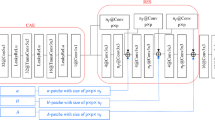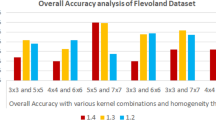Abstract
Polarimetric Synthetic Aperture Radar (PolSAR) images have attracted much attention with abundant polarimetric scattering information. In recent years, many deep learning models have been proposed and highly expanded to PolSAR image classification. However, how to learn the complex matrix information is an indispensable problem. To address this problem, a Wishart Deeplab network is developed, which can not only learn the polarimetric matrix structure by designing Wishart network level but also learn multi-scale polarimetric scattering features by incorporating dilated convolution. Specifically, the Wishart-Deeplab based PolSAR classification model is constructed by designing the Wishart convolution operation to learn the statistical information of PolSAR data. Then, a deeplabV3 + network is followed to obtain the multi-scale semantic features by dilated convolution. By this way, statistical distrubtion-based and high-level semantic features are adaptively learned to improve the performance of the network. The experiments are conducted on two sets of real PolSAR data and results show that this method can obtain better classification results.
Access this chapter
Tax calculation will be finalised at checkout
Purchases are for personal use only
Similar content being viewed by others
References
Shi, J.F., Jin, H.Y., Xiao, Z.L.: A novel multi-feature joint learning method for fast polarimetric SAR terrain classification. IEEE Access 8, 30491–30503 (2020)
Mas, J.F., Flores, J.J.: The application of artificial neural networks to the analysis of remotely sensed data. Int. J. Remote Sens. 29(3), 617–663 (2008)
Taşskın, G.: A comprehensive analysis of twin support vector machines in remote sensing image classification. In: 2015 23nd Signal Processing and Communications Applications, SIU 2015 3, pp. 2427–2429. IEEE, Malatya (2015)
Pajares, G., López-Martínez, C., Sánchez-Lladó, F.J.: Improving wishart classification of polarimetric SAR data using the hopfield neural network optimization approach. Remote Sensing 4(11), 3571–3595 (2012)
Guo, Y.W., Jiao, L.C., Qu, R., et al.: Adaptive fuzzy learning superpixel representation for PolSAR image classification. IEEE Trans. Geosci. Remote Sens. 60, 1–18 (2022)
Salakhutdinov, R., Hinton, G.: Deep boltzmann machines. In: Artificial intelligence and statistics, AISTATS 2009, pp. 448–455 (2009)
Ma, X., Geng, J., Wang, H.: Hyperspectral image classification via contextual deep learning. EURASIP J. Image and Video Processing 2015(1), 1–12 (2015)
Hinton, G.E., Osindero, S., The, Y.W.: A fast learning algorithm for deep belief nets. Neural Comput. 18(7), 1527–1554 (2006)
LeCun, Y., Kavukcuoglu, K., Farabet, C.: Convolutional networks and applications in vision. In: Proceedings of 2010 IEEE International Symposium on Circuits and Systems, ISCAS 2010, pp. 253–256. IEEE (2010)
Chen, X., Xiang, S., Liu, C.L., et al.: Vehicle detection in satellite images by hybrid deep convolutional neural networks. IEEE Geosci. Remote Sens. Lett. 11(10), 1797–1801 (2014)
Saito, S., Aoki, Y.: Building and road detection from large aerial imagery. In: Image Processing: Machine Vision Applications VIII. MVA 2015, vol. 9405, pp. 153–164. SPIE, San Francisco (2015)
Bentes, C., Frost, A., Velotto, D., Tings, B.: Ship-iceberg discrimination with convolutional neural networks in high resolution SAR images. In: 11th European Conference on Synthetic Aperture Radar, EUSAR 2016, pp. 1–4. VDE, Hamburg (2016)
Jiao, L.C., Liu, F.: Wishart deep stacking network for fast POLSAR image classification. IEEE Trans. Image Process. 25(7), 3273–3286 (2016)
Long, J., Shelhamer, E., Darrell, T.: Fully convolutional networks for semantic segmentation. In: Proceedings of the IEEE conference on computer vision and pattern recognition, CVPR 2015, pp. 3431–3440. IEEE, Boston (2015)
Chen, L.C., Papandreou, G., Kokkinos, I., et al.: DeepLab: semantic image segmentation with deep convolutional nets, atrous convolution, and fully connected CRFs. IEEE Trans. Pattern Anal. Mach. Intell. 40(4), 834–848 (2018)
Chen, L.-C., Zhu, Y., Papandreou, G., Schroff, F., Adam, H.: Encoder-decoder with atrous separable convolution for semantic image segmentation. In: Ferrari, V., Hebert, M., Sminchisescu, C., Weiss, Y. (eds.) ECCV 2018. LNCS, vol. 11211, pp. 833–851. Springer, Cham (2018). https://doi.org/10.1007/978-3-030-01234-2_49
Goodman, N.R.: Statistical analysis based on a certain multivariate complex Gaussian distribution (an introduction). Ann. Math. Stat. 34(1), 152–177 (1963)
He, K.M., Zhang, X.Y., Ren, S.Q., Sun, J.: Deep residual learning for image recognition. In: Proceedings of the IEEE conference on computer vision and pattern recognition, CVPR,2016, pp. 770–778. IEEE, Las Vegas (2016)
Acknowledgement
This work was supported by the National Natural Science Foundation of China under Grant 62006186, the Science and Technology Program of Beilin District in Xian under Grant GX2105, in part by the Open fund of National Key Laboratory of Geographic Information Engineering under Grant SKLGIE2019-M-3–2.
Author information
Authors and Affiliations
Corresponding author
Editor information
Editors and Affiliations
Rights and permissions
Copyright information
© 2023 The Author(s), under exclusive license to Springer Nature Singapore Pte Ltd.
About this paper
Cite this paper
Shi, J., He, T., Jin, H., Wang, H., Xu, W. (2023). Wishart Deeplab Network for Polarimetric SAR Image Classification. In: Yu, Z., Hei, X., Li, D., Song, X., Lu, Z. (eds) Intelligent Robotics. CIRAC 2022. Communications in Computer and Information Science, vol 1770. Springer, Singapore. https://doi.org/10.1007/978-981-99-0301-6_8
Download citation
DOI: https://doi.org/10.1007/978-981-99-0301-6_8
Published:
Publisher Name: Springer, Singapore
Print ISBN: 978-981-99-0300-9
Online ISBN: 978-981-99-0301-6
eBook Packages: Computer ScienceComputer Science (R0)




